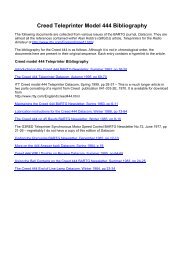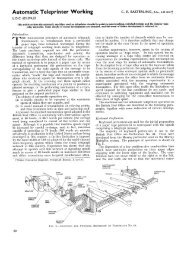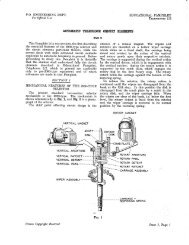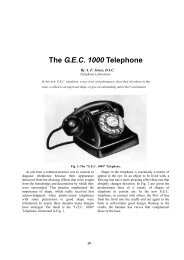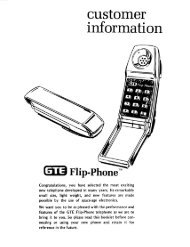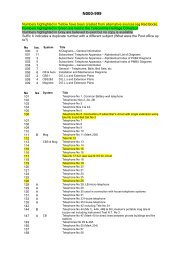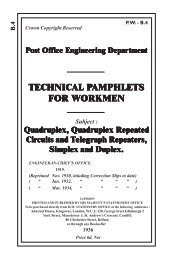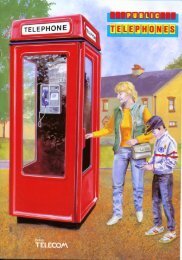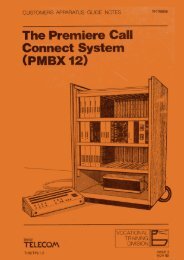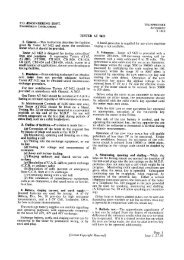TRAFFIC CONTROL TELEPHONE SYSTEMS Circuit - Sam Hallas
TRAFFIC CONTROL TELEPHONE SYSTEMS Circuit - Sam Hallas
TRAFFIC CONTROL TELEPHONE SYSTEMS Circuit - Sam Hallas
Create successful ePaper yourself
Turn your PDF publications into a flip-book with our unique Google optimized e-Paper software.
one is available (if not, with an ordinary watch). Then test the remaining keys<br />
by winding the timed key with one hand and the key under test with the other<br />
hand ; release both at the same time and see if they complete their operation<br />
at approximately the same time.<br />
5. Another test that should be made when the selectors are installed, and one<br />
that it is well to make from time to time (say, every three months) after the<br />
line tests and tests on apparatus in the calling circuit are made and found<br />
correct, is to reduce the potential of the main battery by 50 to 75 volts or<br />
such value as the local conditions warrant, and then call each station in turn.<br />
If there is a failure it will show that some of the apparatus has not the margin<br />
that it should have above the minimum operating voltage. This will give an<br />
opportunity to investigate any weak points that may exist so that they may<br />
be remedied and thus avoid future failure.<br />
Tests on Failure of Operation<br />
When a call is made and the bell does not ring or no answer-back is heard in the<br />
receiver, it is an indication that there is trouble somewhere in the system.<br />
First notice if the usual dull thumps are heard in the receiver when a key is<br />
operated, if not, this is an indication that battery is not being supplied to the line. The<br />
battery connections and operation of the relays in the calling circuit should be examined.<br />
Then call the station on each side of the station that failed. If these do not<br />
respond, it is an indication of line trouble or else trouble in the calling apparatus. Test<br />
the line wires, and if found correct, test the apparatus in the calling circuit as described<br />
under Periodic Tests 2, 3 and 4.<br />
If the stations on each side of the station that failed respond, it is an indication<br />
of trouble with the calling key or else in the apparatus at the way station. This key<br />
should be tested as described under Periodic Tests 2 and 3. If the key is in order, have<br />
the call made for that station and observe if the selector steps up properly to the<br />
ringing position ; if it does and the bell does not ring, test the bell by making a metallic<br />
connection between terminals 1 and 2 on the selector. If the bell rings, it shows a poor<br />
contact or loose connections on the selector. The wiring to the contact springs and the<br />
contact itself should then be examined.<br />
If the bell does not ring when a connection is made between terminals 1 and 2 on<br />
the selector, test the local battery and examine operation of the bell and the answerback.<br />
If it is possible to call the stations on each side of the station that fails and the<br />
calling key for this selector and the bell circuit are correct, it indicates that the selector<br />
is at fault. If the selector does not move at all when a call is made, it indicates an open<br />
in the selector circuit at the way stations.<br />
Page 15



